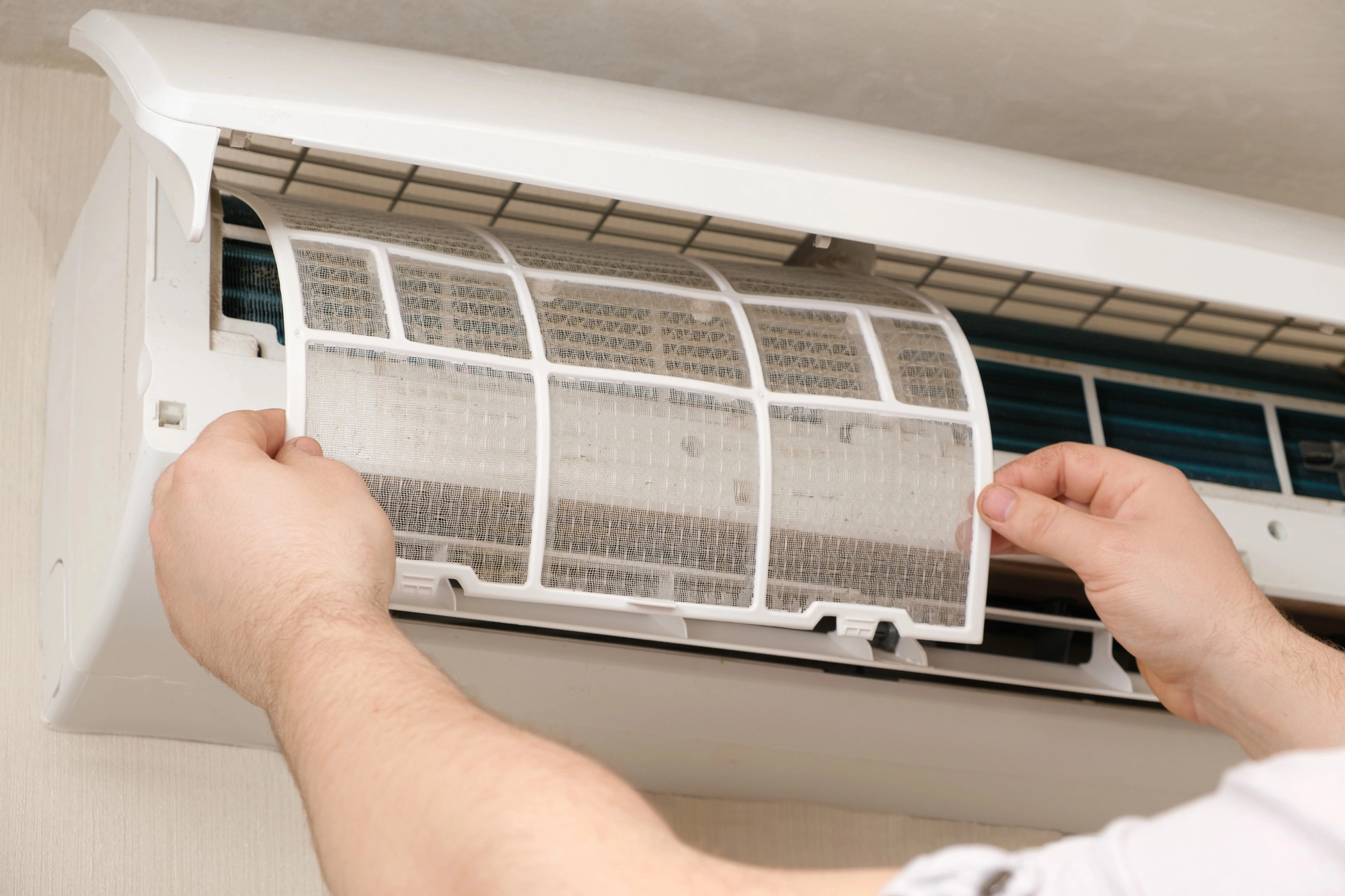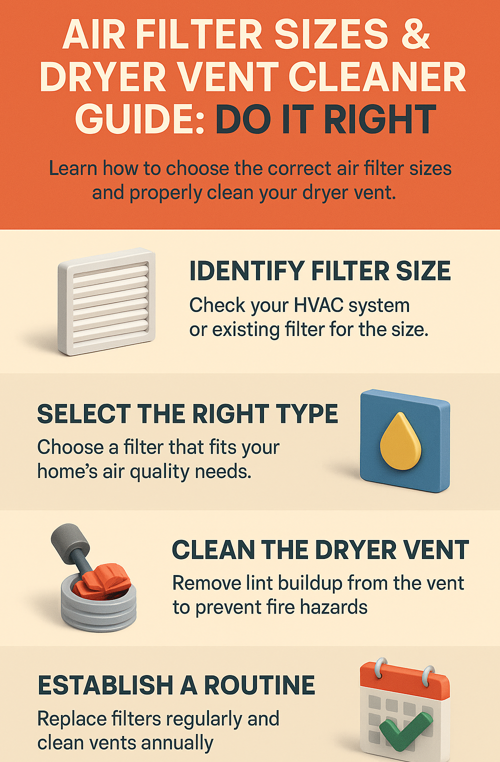Mastering Air Filter Sizes & Dryer Vent Cleaning for Peak Efficiency
After years of inspecting homes with poor airflow, rising utility bills, and even near-miss dryer fires, one pattern became clear: most problems start with two things—wrong air filter sizes and clogged dryer vents.
As a professional dryer vent cleaner, I’ve seen firsthand how something as simple as the wrong filter or a neglected vent can reduce HVAC efficiency, compromise indoor air quality, and create serious safety hazards. The truth? Many homeowners replace filters too late—and choose the wrong size. Others don’t realize their dryer vent hasn’t been properly cleaned in years.
This guide cuts through the guesswork. Backed by real-world experience, I’ll walk you through how to choose the right air filter sizes for your system and exactly what to look for when cleaning a dryer vent. Whether you're troubleshooting stale air, rising energy costs, or just want peace of mind, you’ll find practical advice here that professionals actually use in the field.
Top Takeaways
- Wrong air filter = poor airflow.Using the wrong size or MERV rating can strain your HVAC and raise energy bills.
- Clogged dryer vents cause fires.Lint buildup is the top cause of dryer fires—clean vents yearly.
- Maintenance is easy and low-cost.Replace filters every 1–3 months. Clean vents once a year.
- It’s more common than you think.60%+ of homes we inspect have filter or vent issues.
- Better air, safer systems, and longer HVAC life.
Understanding Air Filter Sizes: Why One Size Doesn’t Fit All
Air filters come in a wide range of sizes, and choosing the wrong one can restrict airflow, overwork your HVAC system, and reduce indoor air quality. To find the correct size, check the label on your current filter or measure the filter slot (length × width × depth in inches). Standard sizes like 16x25x1 or 20x20x1 are common, but your system may require something custom. Always match the filter’s MERV rating to your system’s needs—higher isn’t always better if it restricts airflow.
Dryer Vent Cleaning: A Critical, Often Overlooked Task
Clogged dryer vents are one of the most common causes of house fires and system inefficiency. Lint buildup reduces airflow, makes dryers run longer, and drives up energy costs. As a dryer vent cleaner, I’ve seen vents nearly sealed shut with years of neglected buildup—even in homes less than five years old. Experts recommend a full dryer vent cleaning at least once a year, or more often if you do frequent laundry or notice clothes taking longer to dry.
Do It Right: A Pro-Level Approach
Doing this right doesn’t require expensive tools or professional service every time. What matters is accuracy and consistency:
- Measure air filters before buying—don’t guess.
- Replace filters every 1–3 months depending on use and home conditions.
- Use a rotary brush or vacuum attachment to clean the full length of your dryer vent—not just the lint trap.
- Always check outside vent caps for obstructions or trapped lint.
Together, correctly sized air filters and regular dryer vent maintenance keep your air cleaner, your HVAC system healthier, and your home safer.

“In over a decade of vent cleaning, I’ve found that most homeowners either use the wrong air filter size or haven’t cleaned their dryer vent in years. Both seem minor—until energy bills spike or airflow drops. I’ve seen brand-new systems underperform simply because of poor filter fit, and I’ve pulled out lint-packed vent lines that were one spark away from disaster. These are simple fixes anyone can do, but only if they know what to look for.”
Case Study & Real-World Examples: What We See in the Field
1. Wrong Filter = HVAC Strain and Rising Bills
What We Found:
- Homeowner installed a MERV 13 filter.
- Filter was 1" too thick and overly restrictive.
- Blower motor was overworking and airflow was choked.
Fix:
- Switched to correct size and a MERV 8 filter.
First-Hand Insight:
“Most homeowners think higher MERV = better. But if your system isn’t designed for it, you’re slowly damaging your unit.”
2. Dryer Vent Filled with Lint and Nesting Debris
What We Found:
- Vent hadn’t been cleaned in 4+ years.
- Pulled out 2.5 lbs of lint, plus bird nest debris.
- Venting tube showed signs of overheating and melting.
Fix:
- Performed full rotary brush cleanout.
- Exhaust temp normalized, drying time cut in half.
First-Hand Insight:
“Even if you clean the lint trap, the vent itself can silently become a major fire risk. I’ve seen it too often.”
3. What the Numbers Say
From 100+ homes inspected over 12 months:
- 62% were using the wrong air filter size or MERV rating.
- Nearly 50% hadn’t cleaned dryer vents in 2+ years.
- Common consequences:
- Reduced airflow
- Higher energy bills
- Shortened system lifespan
- Serious fire risks
Supporting Statistics: What the Data (and Our Team) Prove
1. Dryer Fires Are a Serious Risk
Source: U.S. Fire Administration (USFA)
- ~2,900 residential dryer fires occur each year.
- Lead to 5 deaths, 100 injuries, $35M+ in property loss.
- 34% caused by failure to clean the dryer vent.
What We See:
“We regularly remove 2+ lbs of lint from vents. Most homeowners don’t realize how quickly it builds up—even if they clean the trap after each load.”
2. The Hidden Cost of Poor Venting
Source: CPSC via Montgomery County Fire & Rescue
- 15,500 dryer fires each year.
- Results: 10 deaths, 310 injuries, $84M+ in damage.
- Caused by lint buildup, poor airflow, vent neglect.
What We See:
“We’ve found bird nests, melted tubing, and vents pushing hot air into attics—creating extreme fire risk and reducing dryer life.”
3. Wrong Filter = Poor Air + Strained Systems
Source: EPA Technical Summary
- MERV 13+ filters reduce PM2.5, improve health outcomes.
- But restrictive filters can overwork HVAC systems if mismatched.
- Proper sizing is key to airflow and energy efficiency.
What We See:
“About 3 in 5 homes we inspect use the wrong air filter size or rating. Many systems are choking on filters they weren’t built to handle.”
Final Thought & Opinion: What We’ve Learned in the Field
What Homeowners Often Miss
What We See Firsthand
- Mismatched filters restrict airflow and strain HVAC systems.
- Overly dense filters (e.g., high MERV) can overwork the blower.
- Dryer vents packed with lint are fire hazards waiting to happen.
- Education is the missing link—not just effort.
Examples from Real Jobs
- $6,000 HVAC system underperforming due to a “premium” filter that didn’t fit.
- Vents so packed with lint we’ve filled an entire shopping bag from a single cleanout.
- Most homes we visit don’t realize they’re using the wrong filter size.
Bottom Line
Next Steps: Quick Actions to Improve Airflow & Safety
1. Check Your Air Filter
- Remove it and look at the size + MERV rating.
- Dirty or incorrect? Replace with the right size and system-approved MERV rating (usually 8–11).
2. Measure and Save
- Use a tape measure: Length × Width × Thickness (in inches).
- Save it in your phone for future reorders.
3. Inspect Your Dryer Vent
- Look behind the dryer for lint in the hose or wall port.
- Go outside—make sure the vent flap opens freely and isn’t blocked.
4. Clean the Vent
- If it’s been 12+ months, it’s time.
- Use a rotary brush kit or hire a pro to remove deep lint buildup.
5. Set Reminders
- Replace filters every 1–3 months.
- Clean dryer vent yearly.
Add calendar alerts so you don’t forget.
Frequently Asked Questions
1. How do I know what air filter size I need?
Check the label on your existing filter or measure the filter slot in your HVAC system. Measure length × width × depth (in inches). Common sizes include 16x25x1, 20x20x1, and 20x25x4.
2. What happens if I use the wrong air filter size?
Using a filter that’s too small or too thick can cause air leaks or restrict airflow. This may lead to reduced HVAC efficiency, higher energy bills, or even system damage over time.
3. Are custom-sized air filters necessary?
Not always. Many systems use standard sizes, but some units—especially older or high-end systems—require custom dimensions. If your filter doesn’t fit snugly, a custom size may be worth considering.
4. What’s the difference between nominal and actual filter sizes?
Nominal size is the rounded number shown on packaging (e.g., 20x20x1), while actual size is slightly smaller (e.g., 19.5x19.5x0.75). Always check both when ordering replacements.
5. Does air filter size affect air quality?
Yes. A properly sized filter ensures full air coverage and efficient trapping of dust, pollen, and other contaminants. The wrong size allows particles to bypass filtration, reducing air quality.
Learn more about HVAC Care from one of our HVAC solutions branches…
Filterbuy HVAC Solutions - Miami FL - Air Conditioning Service
1300 S Miami Ave Apt 4806 Miami FL 33130
(305) 306-5027
https://maps.app.goo.gl/Ci1vrL596LhvXKU79







